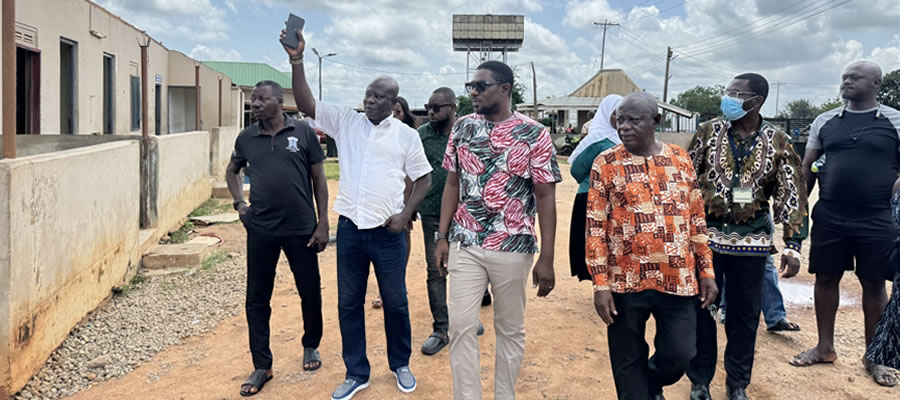

The economy of Atwima Nwabiagya Municipal is categorized into Agriculture, Industry, Trading and Services. In spite of the pre-urban nature of the District, agriculture is the dominant sector, and it employs about 50.76% of the labour force. This is followed by the industrial sector, which employs about 17.41% of the labour force. Trading, that is buying and selling employs 14.43% of the labour force. The service sector comprising of transportation, hairdressing, hospitality and other activities, employs about 17.40% of the labour force.
Agriculture
Crop farming is the principal agricultural activity in the district. The main crops grown in the district are maize, cassava, yam, cocoyam, Ginger, Oil Palm, rice, Citrus and plantain. A wide range of vegetables like tomatoes, garden eggs, pepper and okro are also grown. Most of these crops are cultivated on small-scale basis. There are good soils and large farmlands available for the production of these crops on larger scales.
The District can also boast of the presence of large-scale poultry farms. These include Darko Farms, Asare Farms and Mfum Farms. Other small scale livestock like goats, sheep, pigs, cattle, grass cutter, etc. are also reared
Industry
The main types of industries found in the district are small and medium scale manufacturing enterprises. These include, Food Processing, Wood and Wood Products, Textiles/Dressmaking, Brick and tile making, distillery, chemical products, Pottery, clayware and ceramics, fabricated metal products, leather works, beads making, block moulding and Mineral Water Production. Some of the notable industries in the district include Darko and Mfum Farms Feed Mills, Afari and Mfensi Pottery, Fabi Timbers and others.
Trade and Commerce
Types of trading/commercial activities found in the district include trading in:
• Foodstuffs
• Provisions
• Spare parts
• Alcoholic and soft drinks
• Building Materials
• Cooked foods
• Wood and Wood products
• Plastic products
• Chemicals
• Fuel Products and lubricants
• Etc.
Apart from a few who trade in defined market places, most trading activities in the district are located along roads and residential neighborhoods. Most of the traders are small size retailers. Plan are far advanced by the District Assembly and other private partners (eg SMIDO) to develop an industrial site at Manhyia to relocate small and medium scale industries in the district. A huge parcel of land has already been allocated for that purpose.
Investment And Business Potential
The proximity of the district to the Kumasi Metropolis presents great opportunities for investment especially in the area of Real Estate, Hospitality Industry, Service Industries, Agro-Processing, woodworks, garages etc. Potential investors get the chance to share most of the facilities and infrastructure with the Kumasi Metropolis. Several individuals both within and outside the district have taken advantage of this opportunity.
District Finance
Main Source of Revenue
Sources of revenue for the district can be divided into two broad categories. These are the internal and external revenue sources. The internal sources are made up of seven items, namely;
• Rates
• Fees and fines
• Lands
• Licenses
• Rent
• Interest on investments
• Miscellaneous
The external sources are made up of the following items:
Central Government Grants ( District Assemblies Common Fund, HIPC Funds, etc)
Interest on the District Assembly Common Fund
Others (Donor support such as Kfw, SIF, ADB, etc)
Revenue and Expenditure Situation of the District Assembly
Revenue and expenditure at the assembly largely determines whether it can fulfill its mandate or not. The Assembly’s approved annual estimate for 2009 was GH¢ 2,047,876.17 and actual revenue as at October 2009 was GH¢ 499,006.51. Annual estimated revenue for Rates was GHC 94,800.00 and actual was GHC 79,651.40.Estimates for Lands was 100,000.00 with actual being 79,644.00. Fees and Fines were estimated at 99,605.00 with actual revenue being 56,930.00. Licenses were estimated at 46,200.00 for the year however actual revenue as at October was 34,504.90. Rent was estimated at 864.00 with actual being 106.00. Grants was estimated to bring in 1,684,407.17 with actual being 246,519.51. Estimated Investment revenue was 21,700.00 but actual revenue as at October was 1,650.20. Miscellaneous estimated revenue was 300.00. (All actual are as at October 2009)
The approved expenditure for the same period was 2,045,805.17. Personnel emoluments were estimated to be 375,065 out of which 84,728.13 has been spent as at October 2009. Transport Allowance was estimated at 99,860.00 but so far 74,918.38 has been used. General Expenditure was pegged at 49,603.00 but as at October 2009, 32,962.59 has been spent. Maintenance and Repair was estimated at 20,485.00 and expenditure so far is 12,356.94. Estimated expenditure for Miscellaneous was 82,360.00 and so far, 54, 072.96 has been used. Capital Expenditure was estimated to be 1,418,432.17 and out of that amount, 196, 045, 77 has been expended.
An amount of ¢3,000,000,000.00 was expected as the Districts share of the District Assemblies Common Fund (DACF) for the year, out of this only ¢1,950,791,308.95 was received representing 65% of the allocation for the year. Thus creating a shortfall of ¢1,049,208,691.05 that is about 35% of the allocation. Even though the Assembly did well in terms of the management of the traditional budget for the year, the shortfall in the release of the DACF made it impossible for the assembly to carry on with most of its programmes and projects.
Financial Institutions
There are three commercial banks in the District. These are: Ghana Commercial Bank Ltd. located at Nkawie, Atwima Mponua Rural Bank located at Toase with branches at Abuakwa and Akropong, Nwabigya Rural Bank, a member of the Ghana Club 100,is located at Barekese and Abuakwa.
The financial institutions offer saving and credit facilities to the informal and formal sector. Majority of the populace in the informal sector cannot meet minimum requirements of the commercial banks, hence they save with the rural banks where I minimum of GH¢50 can start an account. The rural banks are mostly involved in micro financing and hence can offer loans at affordable rates to farmers and organized groups. However, the level of poverty is such that majority if these people cannot provide collateral security to enable them source loans.
Date Created : 11/24/2017 4:25:27 AM












 facebook
facebook
 twitter
twitter
 Youtube
Youtube
 +233 593 831 280
+233 593 831 280 0800 430 430
0800 430 430 GPS: GE-231-4383
GPS: GE-231-4383 info@ghanadistricts.com
info@ghanadistricts.com Box GP1044, Accra, Ghana
Box GP1044, Accra, Ghana